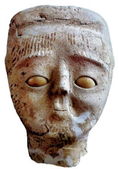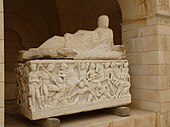Rockefeller Archeological Museum
 Rockefeller Museum, Jerusalem | |
 | |
| Established | 13 January 1938 (opening date) |
|---|---|
| Location | 27 Sultan Suleiman Street, East Jerusalem |
| Type | Archaeology museum |
| Curator | Fawzi Ibrahim |
| Website | imj.org.il/ram |

The Rockefeller Archeological Museum,[1] formerly the Palestine Archaeological Museum ("PAM"; 1938–1967),[2][3] is an archaeology museum located in East Jerusalem, next to Herod's Gate,[4] that houses a large collection of artifacts unearthed in the excavations conducted in the region of Palestine, mainly in the 1920s and 1930s, under the British authorities.[5]
With the beginning of the
The Museum's most prized collection, the Dead Sea Scrolls, were housed in the Museum from their discovery, in 1947, until 1967, when, following the Israeli capture of East Jerusalem, Israel relocated the scrolls to the Israel Museum, in West Jerusalem, with the ownership of these scrolls having been heavily contested ever since. A small part of the scrolls, including the Copper Scroll, had been taken to Amman, and is now part of the collection of The Jordan Museum.[7]
History
Background
Prior to the establishment of the Museum, the
In 1919, British town planner Patrick Geddes proposed the establishment of an antiquities museum in Jerusalem. To further the project, the Mandate authorities proposed a special tourism tax in 1924.[8]
Visiting
Construction, Mandate-time museum (1930–1948)
The museum was designed by


The Palestine Archaeological Museum opened to the public on January 13, 1938.[2] Until the final days of the Mandate period, the museum was administered by the British Palestine Government.[12] On 1 April 1948, it was closed to the public.[13]
Jordanian period (1948–1967)
On 20 April 1948, the High Commissioner appointed a council of international trustees to administer the museum. The council consisted of twelve members: two representing the High Commissioner, one from the British Academy, one from the British Museum, one from the French National Academy, one from the French Ministry of Foreign Affairs, two from the Antiquities Departments of the Egyptian, Syrian, Lebanese, Iraqi or Transjordanian governments; one from the Hebrew University of Jerusalem, one from the Royal Swedish Academy, one from the American Institute of Archaeology, and one from the American School of Oriental Research in Jerusalem.[12][8] The board ran the museum until 1966. In the 1950s, controversies arose about objects removed both to Amman and to the Israeli[clarification needed] side.[14]
After the
Israeli period (since 1967)
Seven months later, when the 1967 Six-Day War broke out, the museum was captured by an Israeli paratroop brigade.[10] Its hexagonal tower was used as a lookout. Fierce fighting took place here between Israeli and Jordanian forces, culminating in an Israeli victory.[citation needed] The Museum was then officially renamed as the Rockefeller Museum.[16]
The Museum's most priced collection, the ancient Dead Sea Scrolls, were moved by Israel from the Museum to the Israel Museum, in West Jerusalem, with the ownership of the scrolls having been heavily contested ever since. Part of the scrolls, including the Copper Scroll, had been taken to the Jordan Museum in Amman.[7]
Since 1967, the museum has been jointly managed by the Israel Museum and the Israel Department of Antiquities and Museums (later reorganized as the Israel Antiquities Authority).
Collections
The museum's first curator was John H. Iliffe,
Upon their discovery at Qumran between 1947 and 1956, the ancient Dead Sea Scrolls were housed in the Rockefeller Museum. In 1967, following the Israeli capture of East Jerusalem, Israel relocated the scrolls to the Shrine of the Book, a specially designed building on the grounds of the Israel Museum, in West Jerusalem, with the ownership of these scrolls having been heavily contested ever since. Part of the scrolls, including the Copper Scroll, had been taken to the Jordan Museum in Amman.[7]
Currently, the Rockefeller Museum holds thousands of artifacts ranging from prehistoric times to the Ottoman period. It includes the largest of the Beisan steles (considered "the most impressive find from Egypt's rule over Canaan")[20] a 9,000-year-old statue from Jericho (one of the oldest representations of a human figure ever found), as well as gold jewelry from the Bronze Age.[21]
-
Head of a statue found in Jericho, among the earliest human representations ever found, dating back to 9,000 years ago
-
Statue of Ramesses III from Beth Shean, 1185–1153 BCE
-
Sarcophagus from Tel Turmus, 3nd century CE, with Dionysos between the seasons of the year. The lid bears the images of the deceased and his wife.
-
Amazon sarcophagus, Tel Mevorah, Roman period, early 3rd century CE; depicts battle between Amazons and Greeks
-
Seven-branched menorah, from the Eshtemoa synagogue, 4th–5th century CE
-
Lintel from the Nabratein Synagogue, 6th-century CE
-
Wood panels from theJami Al-Aqsa, 8th-century CE
-
Sem-nude female statue from Hisham's Palace, 8th-century CE
Exhibitions
The museum regularly hosts special exhibitions, such as the 2019/2021 exhibition of Armenian ceramics in Jerusalem.[22]
Ancient pine tree
Inside what was to have been the rear courtyard of the museum stood (until it died after nearly 300 years in 1998) one of the oldest pine trees in the country. According to Arab legend, on the site of this pine tree,
References
- ^ "Rockefeller Archaeological Museum". www.imj.org.il. 2016-12-18. Retrieved 2021-09-15.
- ^ a b c Kletter, Raz. "The Friends of Antiquities: The story of an Israeli volunteer group and comparative remarks". Journal of Hebrew Scriptures. 8. Article 2.
- ^ Baruch, Yuval; Rachel Kudish-Vashdi. "Historic Background". Rockefeller Museum – The Museum and its Exhibitions. Israel Antiquities Authority.
- The Israel Museum. Archived from the originalon 2012-07-29.
- ISBN 978-1-84162-367-2.
- ^ The Rockefeller Museum, Haaretz
- ^ a b c On the Curious Protests of the Dead Sea Scrolls Exhibition in Toronto
- ^ a b c d Rachel Kudish-Vashdi and Yuval Baruch, Rockefeller Museum: Historic Background. Re-accessed 14 August 2021.
- ^ Beatrice St. Laurent, The Imperial Museum of Antiquities in Jerusalem, 1890–1930 – An Alternate Narrative, Jewish Quarterly, 55
- ^ New York Times. 27 September 1990.
- ^ "Eric Gill, 1882–1940". East Meets West: The Story of the Rockefeller Museum. Israel Museum. Retrieved 31 January 2016.
- ^ a b "Board of Trustees for Museum". Palestine Post. April 22, 1948. p. 3.
- ISBN 1-84553-085-3.
- ISBN 1-84553-085-3.
- ISBN 978-1-85075-650-7.
- ^ Katz, Kimberly (2005). Jordanian Jerusalem: Holy Places and National Spaces. University Press of Florida. p. 134.
- ^ "J H Iliffe Collection" (PDF). Retrieved 4 December 2014.
- ^ In Jerusalem, a Museum's Treasures Go Unseen
- ^ Lakhish Ostraca, c. 587 BCE Archived 2012-11-11 at the Wayback Machine
- ^ "Uncovering the Bible's Buried Cities: Beth Shean". ArmstrongInstitute.org. 2023-03-23. Retrieved 2023-04-16.
One stele discovered from Seti i is called the "Large Stele" and is considered the most impressive find from Egypt's rule over Canaan.
- ^ "Rockefeller Archaeological Museum". www.imj.org.il. 2016-12-18. Retrieved 2021-09-05.
- ^ "A Tantalizing Tour of Jerusalem's Magical Armenian Tiles". Haaretz. 11 December 2009. Retrieved 3 January 2020.
- ISBN 978-0-8276-0004-1. Retrieved 24 November 2010.
Further reading
- Memoirs, David Rockefeller, New York: Random House, 2002.








